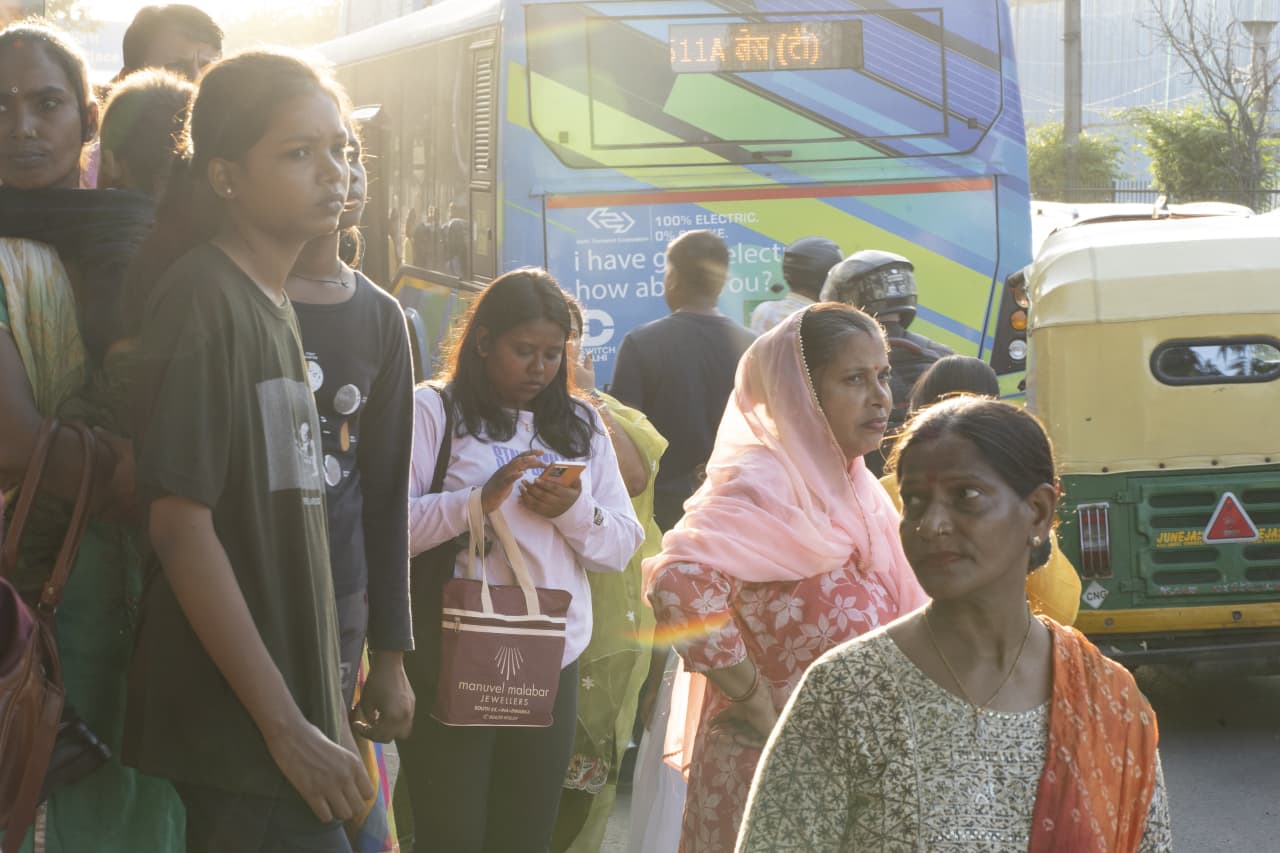For Working Women in India, Staying Safe Can Feel Like a Full-Time Job
Daily planning around ensuring their safety, and reassuring family members, is invisible labour that women do to be able to work
When Ajita Topo , a cook in an affluent neighbourhood in Delhi, leaves work in the evening, she holds her bag like a shield against her chest, keeps her fists clenched and carries a black umbrella with a very sharp end to ward off a possible attack.
She makes sure to wear lots of layers—no matter how hot it is—to deter someone from trying to grope her chest, and secures her bun with a sharp metal stick as an additional weapon.
Topo isn’t being paranoid. Last year, she was followed by two men when she left work after 10 p.m. She managed to scare them away by shouting as she passed homes with guards outside.
“Workplace, public transport, public places, we feel safe nowhere,” said Topo, the sole breadwinner for her two children. “The only solution is to stay alert at all times.”
For many women in India, taking steps to ward off a violent attack—and reassuring their families they are safe while at work and on their commutes—is an invisible form of labour that is a central element of their work life.
The killing and rape of a trainee doctor in the city of Kolkata in August was a fresh reminder for Indian women who work of the dangers lurking in public spaces where women are far less visible than men, from the deserted corners of a hospital or corporate park, in public transport or on city streets.
The 31-year-old was found dead in a seminar hall of the state-run hospital after she went on break during a night shift. A volunteer at the hospital has been arrested as a suspect. The killing prompted protests by women across the country.
Only 30% of women in India aged 15 to 64 were in the labour force in 2022, according to the International Labor Organization, as conservative values lead many families to discourage women working outside the home. In the U.S., the corresponding rate is 68%.
A decade ago, Indian laws dealing with crimes against women were overhauled in the wake of the gang-rape of a 23-year-old woman on a moving bus. But women’s rights advocates say that entrenched patriarchal attitudes haven’t budged significantly, and are at the root of frequent violence against women, both in the home and outside of it.
In other widely publicised incidents, female call centre workers have been assaulted and killed as they commuted to or from night shifts. Last year, a receptionist disappeared from the hotel where she worked and was found dead days later. Each time such a crime takes place, women experience another jolt of fear for their own safety.
Piyali Maiti , clinical director for counselling operations at 1to1help, which manages corporate assistance programs for employees, said worries sparked by the Kolkata attack have cropped up in conversations with employees and their family members in recent weeks.
Sometimes “young professionals are working out in a different city. So family members are also part of our concern group,” she said. “When we have sessions with them, they raise concerns for their child’s safety. ‘What can I do as a parent to make sure my child is safe?’”
For women working in healthcare, where they are a larger share of the workforce compared with many other occupations, but late night shifts and long hours are also common, the Kolkata attack has resonated especially deeply.
Amrita Bhattacharya , a 29-year-old medical resident at another hospital in the city, said she previously felt comfortable walking the distance—less than a mile—from her work to the hospital-provided women’s residence on her own at night. Now she asks a male colleague or friend to accompany her.
Earlier she used to chafe against rules at the residence, which include locking the facility’s doors after a certain hour.
“But now after the horrific incident, I feel being put under lock and key is a must in a society like ours,” she said. “It’s a strain to deal with such fear every day.”
Sexual-assault statistics indicate that women in India are more likely to be raped by a family member, romantic partner or friend, than an acquaintance, employer or stranger. Still, the highly publicised attacks on working women dovetail with existing beliefs held by many that a woman’s place is in the home, shaping decisions made by women and their families.
A Pew Research Center survey in 2019 found 40% of Indians think it is better for a marriage for men to provide while women take care of the home and children, significantly higher than the global median of 23%.
Some women choose to withdraw from work as soon as economic circumstances permit, while others prefer lower-paid work options close to home over travelling to more distant locations.
That perception that working in public is unsafe and homes are safe shows up in India’s newest employers—gig-work platforms. Companies that focus on deliveries have struggled to hire significant numbers of women; the lone exception is Urban Company, a platform that offers personal-care and repair services at home.
The pervasive sense that public spaces are unsafe also shapes company policy. Delivery platform Swiggy at one point limited delivery hours to before 6 p.m. for female workers. The company said in a 2021 blog post on its efforts to hire more women that it reversed the policy after realising it was barring women from earning during peak dinner hours.
Economists and researchers say the low share of Indian women in the workforce is costing India economic growth.
Economic privilege can offer an additional layer of security—such as a personal vehicle for commuting to work, or access to ride-share services that come with some inbuilt safety measures. But, nevertheless, the sense of insecurity persists.
Vidhi Pandey , a digital-marketing professional, has an almost 90-minute commute between her home in Gurgaon and her office in the Indian capital, and frequently attends evening events. If an international client is involved, her day can end at 2 a.m.
“Although my husband and mother have grown accustomed to my unconventional working hours, announcing a late night at the office still makes them lose their sleep,” said the 43-year-old.
Her mother frequently lobbies her to look for something closer to home even if it means earning less. But she has resisted the pressure. Instead, she reminds her mum of her extensive safety checklist.
When she books a cab, she makes sure to look at the driver’s performance rating and reads riders’ feedback regarding his behaviour. If she is wearing a skirt, she changes into something more covered up before getting into a taxi for her ride home.
On her phone, she keeps the Delhi Police panic button app open throughout the ride. The app, developed after the 2012 bus attack and called “Himmat” or “courage,” allows the user to quickly send an alert to the Delhi Police, with a link to the user’s location on Google Maps, as well as notifications to family and friends.
She makes sure to share her live location and trip status with her husband and at least one friend. Sometimes she keeps a phone call going with her mother or a friend throughout the car ride.
“I keep thinking about how to escape if something goes wrong,” said Pandey. “I dream of a day when our society is safe enough for me to travel alone anytime, anywhere without any fear or worry.”
 Copyright 2020, Dow Jones & Company, Inc. All Rights Reserved Worldwide. LEARN MORE
Copyright 2020, Dow Jones & Company, Inc. All Rights Reserved Worldwide. LEARN MORE
A long-standing cultural cruise and a new expedition-style offering will soon operate side by side in French Polynesia.
The pandemic-fuelled love affair with casual footwear is fading, with Bank of America warning the downturn shows no sign of easing.
The pandemic-fuelled love affair with casual footwear is fading, with Bank of America warning the downturn shows no sign of easing.
The boom in casual footware ushered in by the pandemic has ended, a potential problem for companies such as Adidas that benefited from the shift to less formal clothing, Bank of America says.
The casual footwear business has been on the ropes since mid-2023 as people began returning to office.
Analyst Thierry Cota wrote that while most downcycles have lasted one to two years over the past two decades or so, the current one is different.
It “shows no sign of abating” and there is “no turning point in sight,” he said.
Adidas and Nike alone account for almost 60% of revenue in the casual footwear industry, Cota estimated, so the sector’s slower growth could be especially painful for them as opposed to brands that have a stronger performance-shoe segment. Adidas may just have it worse than Nike.
Cota downgraded Adidas stock to Underperform from Buy on Tuesday and slashed his target for the stock price to €160 (about $187) from €213. He doesn’t have a rating for Nike stock.
Shares of Adidas listed on the German stock exchange fell 4.5% Tuesday to €162.25. Nike stock was down 1.2%.
Adidas didn’t immediately respond to a request for comment.
Cota sees trouble for Adidas both in the short and long term.
Adidas’ lifestyle segment, which includes the Gazelles and Sambas brands, has been one of the company’s fastest-growing business, but there are signs growth is waning.
Lifestyle sales increased at a 10% annual pace in Adidas’ third quarter, down from 13% in the second quarter.
The analyst now predicts Adidas’ organic sales will grow by a 5% annual rate starting in 2027, down from his prior forecast of 7.5%.
The slower revenue growth will likewise weigh on profitability, Cota said, predicting that margins on earnings before interest and taxes will decline back toward the company’s long-term average after several quarters of outperforming. That could result in a cut to earnings per share.
Adidas stock had a rough 2025. Shares shed 33% in the past 12 months, weighed down by investor concerns over how tariffs, slowing demand, and increased competition would affect revenue growth.
Nike stock fell 9% throughout the period, reflecting both the company’s struggles with demand and optimism over a turnaround plan CEO Elliott Hill rolled out in late 2024.
Investors’ confidence has faded following Nike’s December earnings report, which suggested that a sustained recovery is still several quarters away. Just how many remains anyone’s guess.
But if Adidas’ challenges continue, as Cota believes they will, it could open up some space for Nike to claw back any market share it lost to its rival.
Investors should keep in mind, however, that the field has grown increasingly crowded in the past five years. Upstarts such as On Holding and Hoka also present a formidable challenge to the sector’s legacy brands.
Shares of On and Deckers Outdoor , Hoka’s parent company, fell 11% and 48%, respectively, in 2025, but analysts are upbeat about both companies’ fundamentals as the new year begins.
The battle of the sneakers is just getting started.
By improving sluggish performance or replacing a broken screen, you can make your old iPhone feel new agai
Micro-needling promises glow and firmness, but timing can make all the difference.























